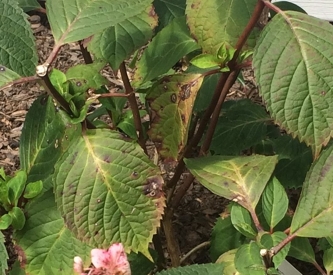Hydrangea Leaves Turning Yellow Things To Know Before You Get This
Wiki Article
The Main Principles Of Hydrangea Leaves Turning Yellow
Table of ContentsNot known Details About Hydrangea Leaves Turning Yellow The 10-Minute Rule for Hydrangea Leaves Turning YellowUnknown Facts About Hydrangea Leaves Turning YellowNot known Details About Hydrangea Leaves Turning Yellow
One possibility is that the plant is not getting enough sunlight. During the winter months, the days are much shorter, and the sun is not as extreme, so see to it to place your Hydrangea in an area where it will access least six hours of sunshine every day. One more factor for Hydrangea yellow fallen leaves in winter months could be excessive water.The fallen leaves might be transforming yellow due to temperature tension. Hydrangeas like cooler temperatures, so if the plant remains in an area that gets also warm or also chilly, the leaves will certainly transform yellow. If you think temperature stress and anxiety may be the problem, try moving your Hydrangea to a various place or securing it from the components with a cloth cover.
New growth will be observed in very early springtime, when you'll see green foliage growing from stems that could have shown up dead. If your fallen leaves are transforming brown in springtime or summertime, there are likely other variables at play. Hydrangea Leaves Turning Yellow. The exact factors depend on the variety and their expanding problems, yet in general, brown hydrangea leaves suggest dehydration and wilting in the heat
In the spring when the mercury stays reasonably reduced, they'll do fine. When points warm up over the summertime nonetheless, time invested in the early mid-day rays can trigger unimaginable damage.: Grow your hydrangeas in a spot where they'll obtain sunlight in the early mornings or nights, yet not during the peak hours.
Getting The Hydrangea Leaves Turning Yellow To Work
Wilting is created by absence of moisture, meaning there are a couple of good techniques to use to prevent this from taking place. Give your hydrangeas a healthy glug of water every few days when the temperatures are climbing high, and deal with the soil to better keep wetness. After sprinkling, a bit of compost around the base of each plant need to assist with this by keeping wetness in the dirt.This interferes with fungis spores from clearing up. "The Botrytis fungus grows in great and damp conditions, so prevent showering the whole plant when sprinkling and simply water at the roots," shares Roy Nicol, a Master Horticulturist - Hydrangea Leaves Turning Yellow. If you have actually missed the possibility for prevention and are blog taking care of an infection you need to eliminate all dead or seriously infected fallen leaves from the plant and ruin them to avoid more spread
As a basic guideline, we suggest getting rid of fallen leaves when they are 50% brownish or higher. While browning triggered by any kind of reason can not be reversed, taking the restorative action explained above will encourage the plant to grow brand-new fallen leaves so the harmed fallen leaves either diminish normally or can be gotten rid of by the garden enthusiast.
Hydrangeas must be watered just when the leading few inches of soil are completely dry, and need to be provided a complete saturating each time. Underwatered hydrangeas are most likely to have yellow, wilting, and sagging fallen leaves.
The Definitive Guide for Hydrangea Leaves Turning Yellow
The way you take care More hints of hydrangea leaves transforming yellow relies on the key issue creating the yellow fallen leaves. This can be hard to determine, once you do you will certainly have the ability to change your plant treatment accordingly to take care of the issue. As stated in the past, a typical problem with hydrangeas is nutrient shortages.Throughout the optimal expanding period, you need to sprinkle at a rate of regarding 1 inch each week. If you are fretted about not properly sprinkling your hydrangeas, there are a couple of points you can do. Adding mulch to the base of the plants over the root area assistance to manage the temperature level around the hedge and preserve water in the soil.

If it is too serious, some plants will certainly never recoup from transplant shock and will certainly continue to decline up until they die. Lessen transplant shock by including as many roots as possible when excavating up your plant to relocate it. Make sure to offer even more water than normal in the weeks following growing to assist your plant recover and expand brand-new roots.
Hydrangea Leaves Turning Yellow - The Facts
To prevent spreading out fungal illness, be sure to thouroughly clean and sanitize any kind of trimming tools before and after usage. You can try to flush the origins with water to get rid of excess fertlizer.
If you don't water your hydrangea plant for even more than a week, the fallen leaves will certainly start turning yellow. Fungal diseases that strike the plants tend to reveal signs on the origins and the fallen leaves of the plant.
Fallen leave spot is another fungal disease that can target hydrangea. It results in the leaves transforming yellow and the look of brownish and purple places on the next leaves.
Report this wiki page